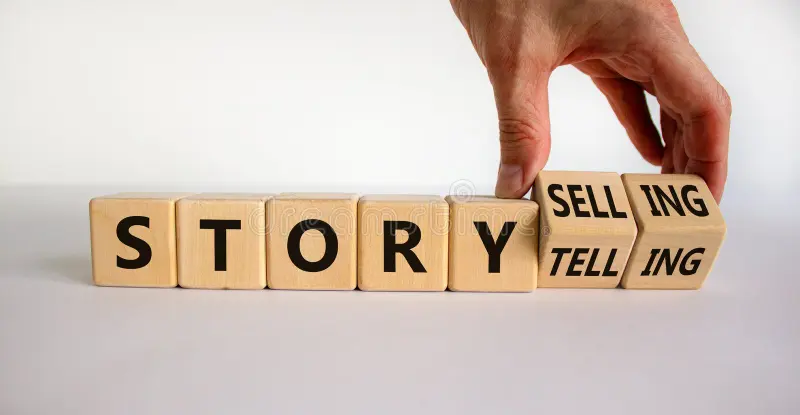Storyselling in 2025: How to Turn Brand Narratives into Real Conversions

In today’s saturated digital marketplace, consumers don’t just buy products—they buy stories. While traditional advertising focuses on features and benefits, modern consumers crave connection, emotion, and purpose. Enter storyselling, the sophisticated art of turning your brand’s narrative into a revenue-driving machine. In 2025, storyselling has evolved from a buzzword into a foundational strategy for forward-thinking brands.
But what exactly is storyselling? And how can you harness its power to create not just brand awareness, but measurable sales? Let’s unpack the concept and explore how to master it.
What is Storyselling?
Storyselling is the fusion of storytelling and selling. Unlike overt pitches or hard-selling tactics, it involves weaving your brand’s values, journey, and mission into a compelling narrative that resonates with customers on a deeper level. It humanizes your brand, builds emotional connections, and leads customers to act—not because they’re pressured to, but because they’re inspired to.
This is not just about telling a story—it’s about selling through the story.
Why Storyselling Works in 2025
With attention spans shrinking and skepticism toward marketing growing, authenticity is currency. Storyselling capitalizes on this by speaking to the heart before the wallet. In 2025, several trends have made storyselling even more critical:
-
Increased competition: Digital noise is louder than ever; a compelling story cuts through the clutter.
-
Consumer skepticism: Audiences question motives and claims. A real story fosters trust.
-
Emotional buying behaviors: Purchases are often emotional first, rational second.
-
Rise of ethical consumption: Buyers care about the “why” behind a brand, not just the “what.”
Elements of a High-Impact Brand Story
To effectively turn narrative into sales, your story must go beyond aesthetics or marketing fluff. It must feel real, rooted in your company’s DNA.
1. The Origin
Start with why your brand exists. Was it a personal frustration? A social mission? A late-night epiphany? Consumers love origin stories that make founders and products relatable.
2. The Challenge
Every good story has tension. What obstacles did your brand face? Highlighting these challenges adds depth and humanizes your journey.
3. The Mission
Clarify what drives your brand forward today. What change are you trying to create in the world? This gives your brand purpose beyond profit.
4. The Transformation
Show how your brand or product brings transformation—either for you, your community, or your customers. This is the value proposition woven into the story.
5. The Customer’s Role
In 2025, customers want to be part of your brand’s story. Position them as the hero. Make them feel they’re not just buying a product—they’re joining a movement.
Techniques to Turn Story into Sales
Crafting a powerful story is just the beginning. The next step is to integrate it strategically across your customer journey.
1. Infuse Story Across Touchpoints
Your brand story shouldn’t live only on the About page. Embed it across:
-
Product descriptions
-
Email campaigns
-
Packaging and unboxing experiences
-
Social media content
-
Live events or webinars
-
Influencer and ambassador messaging
2. Use Video to Humanize Your Brand
Video content remains the most engaging format in 2025. Use behind-the-scenes videos, founder stories, or customer transformations to bring your narrative to life.
3. Leverage User-Generated Stories
Encourage customers to share their own experiences. When real people tell real stories about your product, it creates powerful social proof that converts.
4. Train Sales Teams in Narrative Selling
Your sales force should internalize the brand story and learn to lead with it during conversations. This shifts the dialogue from transactional to relational.
5. Align Product Features with Emotional Drivers
Weave emotional triggers into your feature explanations. Instead of saying “our mattress uses memory foam,” say, “we created this mattress to help exhausted parents finally get a restful night’s sleep.”
Brands Doing Storyselling Right
Allbirds: Their narrative of sustainability, transparency, and simplicity is present in every product, ad, and customer interaction. Consumers don’t just buy shoes—they buy into a movement for a better planet.
TOMS: While the one-for-one model may have evolved, their brand is synonymous with purpose-driven shopping. Customers see their purchase as a direct act of giving.
Glossier: Built on community voices, Glossier’s story is shaped with its customers. Their product development, content, and even branding feel like a story told by the community, not just the company.
Measuring the Impact of Storyselling
While storytelling is emotional, its outcomes should be measurable. In 2025, smart brands track the ROI of their narratives using metrics such as:
-
Conversion rates on story-driven pages
-
Engagement on narrative content (time-on-page, shares, saves)
-
Email CTRs for storytelling sequences vs. promotional blasts
-
Customer lifetime value (CLV) of those who engage with story content
-
Increased brand mentions and sentiment on social platforms
Crafting Your Own Brand Narrative
If you’re ready to build your storyselling strategy, here’s a simple framework to begin:
-
Step 1: Audit your current messaging. Is it product-focused or story-led?
-
Step 2: Define your core story elements—origin, mission, transformation, customer impact.
-
Step 3: Write a long-form brand story as the foundation for all future content.
-
Step 4: Slice that story into multiple formats: short reels, blog posts, social captions, testimonials.
-
Step 5: Distribute consistently across all platforms and customer touchpoints.
Final Thoughts
In 2025, storyselling is not a gimmick—it’s a necessity. As consumers demand deeper meaning behind every transaction, your brand’s narrative becomes its greatest asset. It’s no longer enough to have a good product. You must have a story worth buying into.
Remember, people may forget features, but they rarely forget how a story made them feel. And in the quiet space between logic and emotion—that’s where the sale truly happens.













